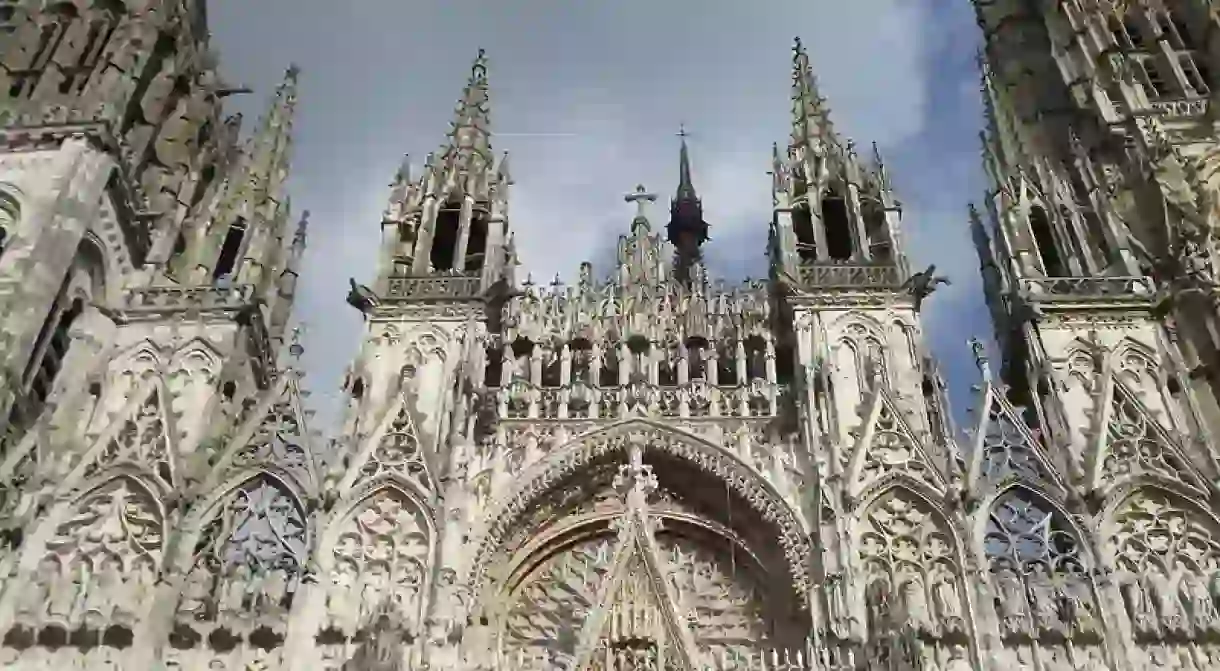A Brief History of Notre-Dame Cathedral, Rouen

Darting through the skyline of the French city of Rouen, the capital of the Normandy region, the Notre-Dame Cathedral is the epitome of grand and ornate Gothic architecture at its finest. Opened in 1876, today the cathedral is one of the most important sites in Rouen and arguably in all of Normandy. Read on for a brief history of the cathedral and then go and see it for yourself.
In the beginning…
The church, the official name of which is cathédrale primatiale Notre-Dame-de-l’Assomption de Rouen, first began construction in the 12th century; its foundations are a basilica from the 4th century and a Romanesque cathedral from the 11th century. Throughout the years, it experienced hardships including a fire in 1200, damage by the Calvinists during the French Wars of Religion in the 16th century, and bombings during the Second World War. It held the title of the tallest building in the world from 1876 to 1880, until it was surpassed by the Cologne Cathedral. It is still considered to be the tallest cathedral in France.

The pinnacle of Gothic architecture
While the church carries an important history, perhaps its most intriguing feature is its spectacular example of Gothic architecture. Its flamboyant facade showcases all the style’s typical elements: three-pointed arched portals entering into the church, decorated with statues symbolising religious doctrine, and immense in size, particularly height. The church displays the full spectrum of Gothic architecture eras, from early to late and even Neo-gothic in its spire.

The cathedral’s influence in art and music
Unsurprisingly, this impactful building located in one of the most important cities of Normandy influenced the artists of the region, particularly Camille Pissarro and Claude Monet. Both of these Impressionist painters included the grand cathedral in some of their works: Monet captured it more than 30 times in varying light and weather and it can be seen in dominating the background in Pissarro’s Rue de l’Épicerie. Also notable is the cathedral’s musical reputation, one it’s held since the Middle Ages, especially with regards to the organ. Baroque musician Jean Titelouze, known as the “father of the French organ school”, worked in the cathedral from 1588 until his death in 1633.

Within the cathedral walls
The Cathedral of Notre-Dame was where the Dukes of Normandy were traditionally crowned, as well as where many of them were buried; their tombs are still housed by the church today. Most notable is the tomb containing the heart of former Duke of Normandy and King of England, Richard the Lionheart. There is also a plaque commemorating the former crypt of the Duke of Bedford, John Plantagenet, one of the main overseers in the trial of Joan of Arc. His original black marble tomb was demolished by the Calvinists in the 16th century.

The spectacular show of lights
Try to plan a visit to Rouen to coincide with the Cathedral of Lights show: an epic display that takes place annually, illuminating the church with vivid images and accompanied by music, pertaining to the theme of the year. Past themes have included Impressionism and Joan of Arc and the Vikings. More information regarding the festival can be found by visiting the tourism board’s website here.

Notre-Dame Cathedral, Place de la Cathédrale, 76000 Rouen, France, +33 2 35 71 71 60













